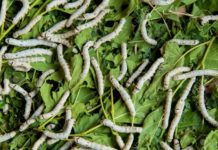Introduction
Mushroom is the fleshy form of a fungus, it has two divisions cap-like structure is known as pileus and attached with thread-like structure is known as mycelia, mycelia consume nutrient from soil, it does not need sunlight for their growth. Mushrooms are lack of chlorophyll so they can’t do photosynthesis like other green plants. Typically fungus is produced above ground on soil or its food source. We can’t simply eat all types of mushrooms. There are more than thirty thousand identified types of mushroom worldwide. Ninety-nine per cent of mushroom are safely editable and another one per cent of mushrooms are poisonous. Mushroom cultivation is one of the most successful agribusinesses that can be started by the least investment and space.
Types of Cultivable mushrooms
- White Button Mushroom
- Paddy Straw Mushroom
- Oyster Mushroom



Oyster Mushroom
Large Scale Mushroom Cultivation
Total infrastructure required
|
S.no |
Facility |
Unit |
Size |
Total area (sq.ft) |
|
1 |
Cropping rooms |
4 |
25’x13’x12’ |
1300 |
|
2 |
Corridor |
1 |
52’x6’x13’ |
312 |
|
3 |
Packing room |
1 |
15’x10’x12’ |
150 |
|
4 |
Composting Yard |
1 |
40’x40’ |
1600 |
|
5 |
Pasteurization tunnel |
1 |
15’x7’x12’ |
105 |
|
6 |
Boiler room |
1 |
10’x10’x12’ |
100 |
|
Total area wanted -3597 sq.ft |

Infrastructure
Machinery required
- Four self-contented AHU’s(Air Handling Unit)
- Boiler 150 kg steam generation capacity
- Centrifugal blower along with ducting
- Steel racks in the growing room and iron gratings in the tunnel
- Electrical and other installations
- Water pipeline and fittings
- Petty equipment like thermometers, sprayers, forks, harvesting trays, etc.
Steps to cultivate mushrooms
- Production or procurement of spawn
- Preparation or procurement of compost
- Spawning
- Casing
- Cropping
Production or procurement of spawn
You can produce own spawn or it can be procured from a reliable lab located in the region, the spawn is the seed needed for producing mushrooms or in simple words spawn is the grains coated with mushroom mycelium technically spawn is the vegetative mycelium of a chosen mushroom grown on any convenient medium like wheat, pearl, millet, sorghum, etc.
Preparation of compost
Preparation of compost can be done by three methods
- Long Method,
- Short Method,
- Indore Method.
Long Method
The Long method is the very old and traditional method of compost making and usually seasonal cultivators prepare composed by this method compost can be made by this process in one month’s time during which it is turned seven to eight times by this technique around fifteen to eighteen KD mushrooms can be produced from 100kg compost in three months period, the formulations needed for this method are
| Wheat straw or paddy straw | 300 Kg |
| Wheat bran | 15 Kg |
| Can | 9 Kg |
| Urea | 3 Kg |
| Superphosphate | 3 Kg |
| Muriate of Potash | 3 Kg |
| Gypsum | 20 Kg |
To begin the composting method first thoroughly clean the area and spray two per cent of formaldehyde. On next day wheat straw or any other base material is spread on the platform water is sprayed over the straw through the pipe and straw is often turned till it absorbs around 75% moisture nearby four thousand litres of water and ton of straw would be needed. When the straw is fully fitted it is collected as a low heap on one side of the yard. Similarly, another ingredient except for gypsum is mixed and kept as such in the yard, in a heap long method compost is prepared in around 28 days, during this period compost is turned at least seven to eight times. Now we will be telling you to devise methods.
Day:0 On this day two ingredients that are straw and other additives are properly mixed the mixed ingredients are then made into a high aerobic pie dimensions of the pile should be five feet wide five feet in height and length will depend upon the quantity of the substrate day one to five this file is kept as such for five days temperature of heap starts rising and may go up 70-75 celsius in 24 -48 hours day six on the sixth day first trunin is given to the pile .pile is broken and the substance is mixed well and then a new pile is constructed strong smell of ammonia can be noticed during this phase after the first turning temperature starts rising again after 24 hours .
Day:10 The pile is broken again and turned second time as earlier I’ll show some shrinkage and exhibits higher temperature the colour of the ingredient starts darkening too deep brown ammonia production is higher at this stage now white flags are powdery masks which are known as fire fangs as you know my CD’s are also visible which is the indication of good compost .
Day: 13 Again the pile is turned third-time and the required quantity of gypsum is added and mixed well.
Day 16,19,22,25 Turnings are given and on 25th day the required quantity of the insecticide is added during the last turning and spraying of Melathion or Decis at 0.01% to be sprayed can be done for killing insects and pests.
Day: 28 This is the last day and also called spawning tale the pile is broken and the smell of ammonia is checked if no ammonia smell is there and instead of sweet smell is felt the compost is ready for spawning if ammonia smell persists then give additional turning before spawning compost is cooled down to ambient temperature by spreading it on the floor, a good is a dark brown in colour non greasy or sticky and have a distinct sweet and offensive smell from ammonia half 66-68% moisture and 7.2-7.8 pH there is no visible growth of other undesirable organisms except for the fire fanga and is free from insects and nematodes this direct rate has developed the chemical pasteurization technique for long method compost for the control of yellow mould and also to improve the eels in this technique we take 1.5 liters of formalin and 50 gram of bevistin dissolve chemicals in 40 liters of water for one ton composed spray the solution throughly in the entire compost mass now make a heap out of this compost and cover it by polythene sheet for two days remove cover after two days and vigorously shake the compost and later spawn this compost.
Short method
Short method of composting is generally employed by the growers who have round the ear cultivation facilities this method consists of two phases .phase one is outdoor composting 10-12 days, phase two is pasteurization and conditioning of the compost inside the tunnel, which lasts for around seven days the formulation required for this method are
| Wheat straw | 1000 Kg |
| Chicken manure | 400 Kg |
| Wheat bran | 70 Kg |
| Urea | 14.5 Kg |
| Gypsum | 30 Kg |
Phase one of outdoor composting
At this stage, first wheat straw is wetted completely and then chicken manure is mixed along with the addition of wheat bran and kept as such for two days after that stack is broken and water is added to the dry portions and again a stack is made zero-day on this day the stack is again broken the whole quantity of urea is added and a high aerobic pile is made the compost is again turned after every two days and gypsum is added a third turning and all three to four turnings are given temperature of the pile may range between 70-80 Celsius on 8th till 10th day the compost is ready for pasteurization in bulk chamber this makes the end of phase one.
Phase two of composting
Composting is made in pasteurization tunnel fill the tunnel with compost up to the height of 2-2.3 metre manually or by filling line or bobcat. Then install thermometers probe one each in plenum compost and in the air above the compost close all doors ventilators and switch on the blower fan to bring the uniform temperature in the tunnel between 45-48 Celsius, now lightly open the fresh air damper and maintain the temperature in the range of 48-52 Celsius and the compost for 48 hours for pre pasteurization conditioning now raise the compost temperature to 59-60° celsius by manipulating the opening of the damper or by injecting steam through a boiler keep composter at this temperature for four to six hours again bring down compost temperature between 48-52 celsius range keep it for three to four days or till the period when there is no ammonia smell in the compost you can also check ammonia by using dagger and ammonia tube if no ammonia persists bring down the compost temperature to 25-30 celsius now the compost is already the first spawning.
Indore Method
Indore composting is the recent method of composting production. In this method compost is prepared in twelve days time without any environmental pollution in this method phase is performed in specially bunkers which are also known as phase one tunnels these bunkers are provided with ventilation arrangements in this method all the ingredients as mentioned for short method are totally mixed and properly fitted and kept as such in a heap in the composting yard for two to three days these ingredients are changed to bunkers and the blower fan is switched on for three minutes on and two minutes off with the help of the timer ,temperature of the pile may go up to 80 degree celsius compost is kept in the bunker for three days after that this mass is taken out properly mixed and transferred to another bunker where again this is kept for three days and similar procedure followed thereafter this compost is transferred to phase two tunnels and procedure as mentioned short method is followed.
Spawning
Next step in the cultivation cycle of a mushroom is to spawn. The ready compost prepared by either of the shown methods select a suitable area for spawning preferably cemented platform or room sprinkled the area with 2% of formaldehyde 24 hours spawning operation completely mix spawn in the compost in the ratio of 500 to 750 gram of spawn in per 100 kg of composed, under clean conditions Felton kg spawn composed in each of polythene bag of size 22 by 24 inches up to the height of 30 cm ,the compost can also be spread in shale beds approximately 5-6′ inches deep ina covered mushroom house loosely seal the mouth of polythene pack filled with spawned compost and covered with the clean newspaper or plastic sheet, it in beds or shelves shift the compost filled bags in cropping rooms having air temperature of 23+or- 1° c, keep bag in this conditions for 12 -14 days compost if kept in the past growing rooms and beds and covered with newspaper will require gentle water spray once in a day to avoid drawing of the compost there is no need of water spray if compost is covered with poly sheets under these conditions spawn run will complete in 12-15 days and the compost will turn into white in colour.
Casing
Casing and case run is an essential step in the cultivation cycle of mushroom, without casing mushroom will not appear. The casing is applying a layer of soil around 4.5 cm thick on the top surface. The spawn run compost a mixture of 2-3 years old farmyard manure with garden soil in the ratio of 1:1 is prepared if carpet available in your area then it can also be used in combination of FYM and garden soil in the ratio of 1:1:1 formalin is the most suitable material to treat the casing soil for the farmers who do not have control facilities. It kills all kinds of diseases and animals, for casing treatment following steps are involved make a heap of casing materials on a cemented platform and wet it thoroughly drenched the wet casing with formalin at 2 litres dissolved infertility of water or m3 by mixing with a shovel. Cover it by polythene sheet and seal the outer periphery thereafter by pouring sand and soil on outside margin gives the material for 5-6 takes in a sun for fumigation effect. Remove the cover and expose the material to open air by turning the materials free use growers who have controlled conditions may treat their casing soil with steam.
In casing soil chamber built for purpose .casing is pasteurized at 65° celsius for 6-8 hours by live steam in this chamber after it’s cooling to 25° celsius it’s ready for application for casing application unfold the fully spawn run bag and make the top surface even by its gentle pressing with hands apply 4.5 cm thick layer of casing uniformly on the surface spray water immediately after application and they are after daily water is so sprayed, that it does not travel to compost daily .
Water spray to the casting till termination of crop after casing mycelium will travel in the casing soil this process is known as case run, which is done at a temperature of 23-25 ° celsius with RH of 95 % and carbon dioxide of about 10,000 ppm for about one week must the mycelium reaches the casing soil now compost is ready for fruiting.
Cropping
The mushroom will not appear in the bags or beads except you give a shock to the mycelium or compost and for this, we change the environmental conditions altogether first we bring down the air temperature to 15-17° celsius.RH to 85% and we provide enough ventilation to the compost or room which brings down the co2 concentration to 800 till 1,000 ppm this change in environmental parameters induces pinhead formation in 3-4 days time, the pinheads develop into solid button size mushrooms in 3-4 days at this stage the air inside the cropping room is change to 4-6 times in an hour to maintain appropriate carbon dioxide concentration ,given above condition you will get the first harvest ready after33-34 days of spawning mushroom with 4-5 cm diameter close to vail are harvested.
Mushrooms are harvested holding them between forefinger and thumb by rotating it in the clockwise and anti-clockwise direction. The soil stem portion is cut with sharp knife and mushrooms are collected grade-wise in baskets daily watching to the bags or beds is required. Water is so sprayed that it remains to the casing soil only and does not least it down to the compost, if required water can be sprayed 2 times on the bags ,mushrooms appear in the flushes after harvesting mushrooms for 2 -3 days there is a gap when they reappear 1.8-2kg mushrooms are harvested per bag of 10 kg compost each in 30 -40 days of cropping.











